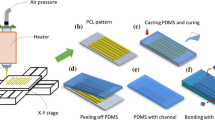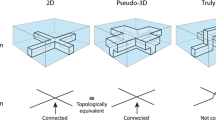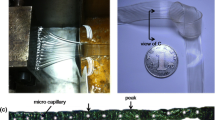Abstract
Micro-wire molding fabrication methods are simple and inexpensive techniques that benefit from the properties of polydimethylsiloxane. However, this approach generally can’t be used to form intersecting microchannels, which limits the scope of achievable geometries. This article describes the optimization of a micro-wire molding method that allows for the fabrication of complex channels, which connect various templates without using bonding treatments or dissolving templates. Meanwhile, the relationship between the volume of glue and the deformation zone was explored. Then, Channels manufactured in this way were used for the droplet generation and mixing experiments. Both T-channel and cross-channel were fabricated and optimized using this method, and their droplet-generating capabilities were investigated. Overall, the results verified that these structures were attainable and applicable as droplet generators. Further, more complex channels could be constructed by combining templates with different dimensions and shapes to generate multifunctional microfluidic chips. The results presented herein indicate that complex channels with multifunctional applications can generate and mix droplets, which further confirms the versatility and practicability of this complex microchannel-forming technique.







Similar content being viewed by others
Data availability
The data that support the findings of this study are available on request from the corresponding author, Li Zhu, upon reasonable request.
References
Abgrall P, Gué AM (2007) Lab-on-chip technologies: making a microfluidic network and coupling it into a complete microsystem—a review. J Micromech Microeng 17(5):15–49. https://doi.org/10.1088/0960-1317/17/5/R01
Adams LLA, Kodger TE, Kim SH et al (2012) Single step emulsification for the generation of multi-component double emulsions. Soft Matter 8(41):10719–10724. https://doi.org/10.1039/c2sm25953b
Anderson JR, Chiu DT, Jackman RJ et al (2000) Fabrication of topologically complex three-dimensional microfluidic systems in PDMS by rapid prototyping. Anal Chem 72(14):3158–3164. https://doi.org/10.1021/ac9912294
Beauchamp MJ, Nordin GP, Woolley AT (2017) Moving from millifluidic to truly microfluidic sub-100-μm cross-section 3D printed devices. Anal Bioanal Chem 409(18):4311–4319. https://doi.org/10.1007/s00216-017-0398-3
Bhattacharjee N, Urrios A, Kang S et al (2016) The upcoming 3D-printing revolution in microfluidics. Lab Chip 16(10):1720–1742. https://doi.org/10.1038/s41598-020-65483-2
Duffy DC, Mcdonald JC, Schueller O et al (1998) Rapid prototyping of microfluidic systems in poly(dimethylsiloxane). Anal Chem 70(23):4974–4984. https://doi.org/10.1021/ac980656z
Garstecki P, Fuerstman MJ, Stone HA, Whitesides GM (2006) Formation of droplets and bubbles in a microfluidic T-junction scaling and mechanism of break-up. Lab Chip 6(3):437–446. https://doi.org/10.1039/b510841a
Li G, Xu SY (2015) Small diameter microchannel of PDMS and complex three-dimensional microchannel network. Mater Des 81(15):82–86. https://doi.org/10.1016/j.matdes.2015.05.012
Ng JMK, Gitlin I, Stroock AD et al (2002) Components for integrated poly(dimethylsiloxane) microfluidic systems. Electrophoresis 23(20):3461–3473. https://doi.org/10.1002/1522-2683(200210)23:20%3c3461::AID-ELPS3461%3e3.0.CO;2-8
Paques JP, van der Linden E, Sagis LMC et al (2012) Food-gradesubmicrometer particles from salts prepared using ethanol-in-oil mixtures. J Agric Food Chem 60(34):8501–8509. https://doi.org/10.1021/jf3023029
Qin D, Xia Y, Whitesides GM (2010) Soft lithography for micro- and nanoscale patterning. Nat Protoc 5(3):491–502. https://doi.org/10.1038/nprot.2009.234
Raoufi MA, Bazaz SR, Niazmand H et al (2020) 3D Fabrication of unconventional inertial microfluidic channels using wax 3D printing. Soft Matter 16(10):2448–2459. https://doi.org/10.1039/C9SM02067E
Raoufi MA, Bazaz SR, Niazmand H et al (2020) Fabrication of unconventional inertial microfluidic channels using wax 3D printing. Soft Matter 16(10):2448–2459. https://doi.org/10.1039/C9SM02067E
Shallan AI, Smejkal P, Corban M et al (2014) Cost-effective three-dimensional printing of visibly transparent microchips within minutes. Anal Chem 86(6):3124–3130. https://doi.org/10.1021/ac4041857
Song SH, Lee CK, Kim TJ, Shin IC et al (2010) A rapid and simple fabrication method for 3-dimensional circular microfluidic channel using metal wire removal process. Microfluid Nanofluid 9(2–3):533–540. https://doi.org/10.1007/s10404-010-0570-y
Sun BJ, Shum HC, Holtze C et al (2010) Microfluidic melt emulsification for encapsulation and release of actives. ACS Appl Mater Interfaces 2(12):3411–3416. https://doi.org/10.1021/am100860b
Tachibana D, Matsubara K, Matsuda R et al (2020) 3D helical micromixer fabricated by micro lost-wax casting. Adv Mater Technol 5(1):1900794. https://doi.org/10.1002/admt.201900794
Takeuchi S, Garstecki P, Weibel DB, Whitesides GM (2005) An axisymmetric flow-focusing microfluidic device. Adv Mater 17(8):1067–1072. https://doi.org/10.1002/adma.200401738
Tang WL, Fan N, Yang JQ et al (2019) Elasto-inertial particle focusing in 3D-printed microchannels with unconventional cross sections. Microfluid Nanofluid 23(3):42. https://doi.org/10.1007/s10404-019-2205-2
Thorsen T, Maerkl SJ, Quake SR (2002) Microfluidic large-scale integration. Science 298(5593):580–584. https://doi.org/10.1126/science.1076996
Unger MA et al (2000) Monolithic microfabricated valves and pumps by multilayer soft lithography. Science 288(5463):113–116. https://doi.org/10.1126/science.288.5463.113
Utada AS, Lorenceau E, Link DR et al (2005) Monodisperse double emulsions generated from a microcapillary device. Science 308(5721):537–541. https://doi.org/10.1126/science.1109164
Verma M, Majumder AA, Ghatak A (2006) Embedded template-assisted fabrication of complex microchannels in PDMS and design of a microfluidic adhesive. Langmuir Acs J Surf Colloids 22(24):10291–10295. https://doi.org/10.1021/062516n
Wang Q, Liu SS, Wang H et al (2015) Alginate droplets pre-crosslinked in microchannels to prepare monodispersed spherical m icr ogels. Colloids Surf A Physicochem Eng Aspects. 482(2):371–377. https://doi.org/10.1016/j.colsurfa.2015.06.041
Wei C, Yu C, Wu JJ et al (2019) Easy-to-operate fabrication of tapered glass capillaries for microdroplet generation. J Micromech Microeng 29(3):37001. https://doi.org/10.1088/1361-6439/aafd9d
Wu P, Wang Y, Luo Z et al (2014) A 3D easily-assembled micro-cross for droplet generation. Lab Chip 14(4):795–798. https://doi.org/10.1039/c3lc51126j
Wu JW, Xia HM, Zhang YY et al (2018) An efficient micromixer combining oscillatory flow and divergent circular chambers. Microsyst Technol 25(7):2741–2750. https://doi.org/10.1007/s00542-018-4193-7
Zhang YY, Xia HM, Wu JW et al (2019) Synchronized generation and coalescence of largely dissimilar microdroplets governed by pulsating continuous phase flow. Appl Phys Lett 114(7):73701. https://doi.org/10.1063/1.5084188
Zou MS, Cai SX, Zhao ZL et al (2015) A novel polydimethylsiloxane microfluidic viscometer fabricated using microwire-molding. Rev Sci Instr 86(10):104302. https://doi.org/10.1063/1.4933388
Funding
This work was supported by the National Natural Science Foundation of China (51705257). Postgraduate Research & Practice Innovation Program of Jiangsu Province (KYCX20_0268).
Author information
Authors and Affiliations
Corresponding author
Additional information
Publisher's Note
Springer Nature remains neutral with regard to jurisdictional claims in published maps and institutional affiliations.
Rights and permissions
Springer Nature or its licensor (e.g. a society or other partner) holds exclusive rights to this article under a publishing agreement with the author(s) or other rightsholder(s); author self-archiving of the accepted manuscript version of this article is solely governed by the terms of such publishing agreement and applicable law.
About this article
Cite this article
Wang, M., Zhu, L. & Zhang, C. Optimization and application of a micro-wire molding fabrication method of microfluidic devices. Microsyst Technol 29, 1053–1063 (2023). https://doi.org/10.1007/s00542-023-05502-0
Received:
Accepted:
Published:
Issue Date:
DOI: https://doi.org/10.1007/s00542-023-05502-0




